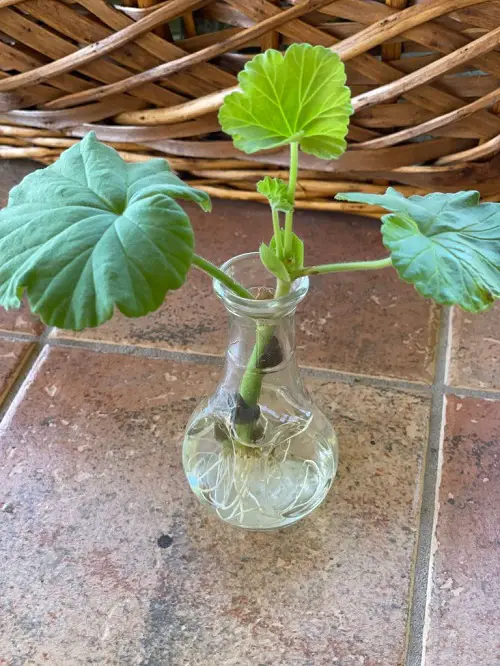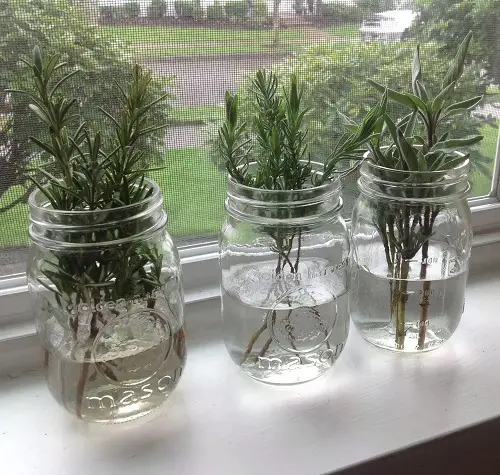No soil, no rooting hormones, no mess—propagate our selection of Flowering Plant Cuttings in just Water and nothing else!
There are many ways to root clippings—most entail potting mix, right-sized containers, rooting hormones, and plenty of patience. But to propagate these flowering plant cuttings, all you need is crystal-clear water that lets you sit back and watch roots sprout mud-free!
Flowering Plant Cuttings to Propagate in Water
1. Geraniums
Botanical name: Pelargonium
Can geranium cuttings root in water? Yes, this classic garden bed and container flower with long-lasting blooms in reds, pinks, purples, and whites can be propagated easily in water in just a few steps. It all begins with picking a healthy stem from a strong, robust branch!
Cut right below the leaf node during its growing phase, in spring or summer. Then, remove the leaves at the bottom, where you want the clipping to root, and leave a few at the top.
Since geraniums cannot tolerate extreme winter, you can also do this to overwinter them in fall and have many specimens ready till spring!
Ensure the cutting is at least 4-6 inches long, and drop it in a vase filled with just enough water to cover the stem but not the leaves. And once roots sprout and become long enough, transplant your geranium baby plant to a container!
2. Impatiens
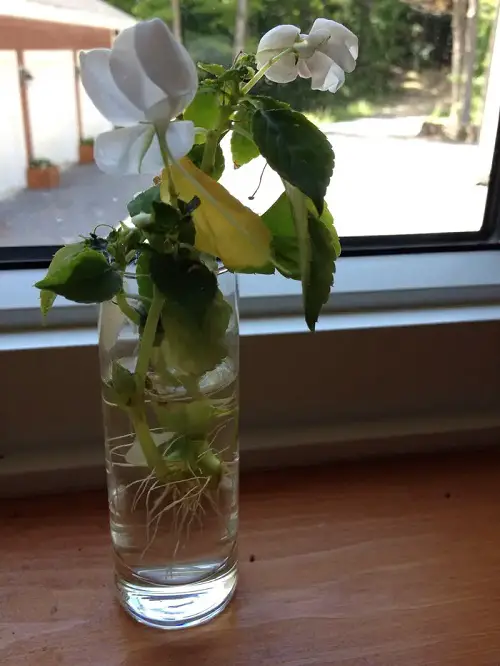
Botanical name: Impatiens spp.
Next, we come to the popular impatiens plant with its brightly colored, pigmented blooms in purple, yellow, pink, and red flowers and different shapes! Impatiens is an easy-to-care-for plant that flowers even in the shade, making it perfect for indoor gardening.
To propagate impatiens in water, drop the cutting in a jar filled with water, covering up to a couple of nodes on the stem, and avoid wetting the leaves on top. Provide it with ample filtered sunshine.
Once the cuttings root in water, you can plant them in pots, window boxes, hanging planters, and even beds, as long as they get shade and moisture.
3. African Violet
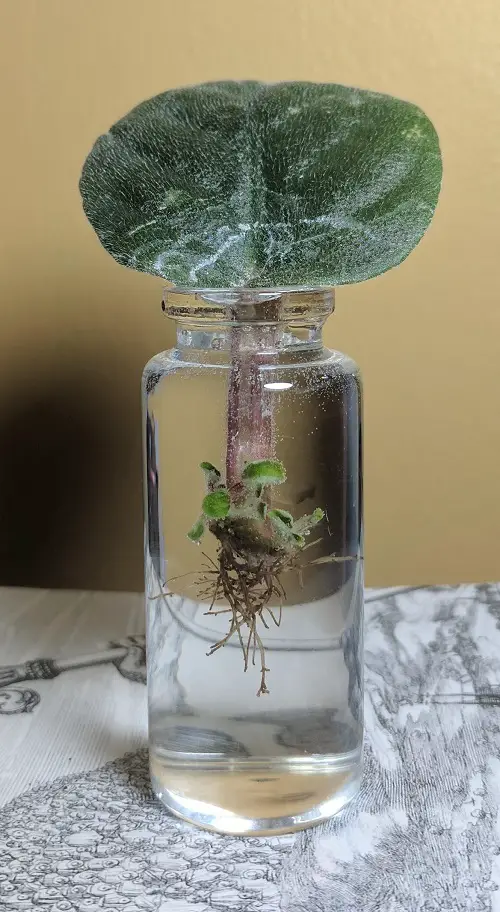
Botanical name: Saintpaulia ionantha
Did you know you can propagate the double-crowned and fuzzy African violet in water from a single leaf? Simply dip a portion of the leaf in a see-through jar filled with water, and sit back and enjoy the show! The leaf will soon start rooting if it sits in indirect sunlight.
You can also use fluorescent lights in the absence of dappled sunshine or even too much direct sun! Grow lights prevent leaf burn and almost always yield thriving plants. And don’t forget to read our guide on getting your African violets to bloom year-round!
4. Begonia
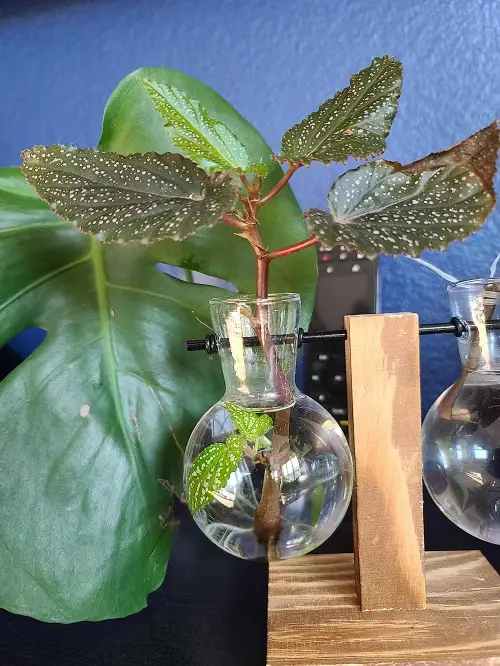
Botanical name: Begonia spp.
Begonias may grow from seeds, but the ease and thrill of propagating their cuttings in water is second to none! Cut 3-4 inches of a healthy stem from a healthy begonia branch and drop it in a water-filled glass jar, submerging the nodes and not the leaves.
Your begonia clipping will root well under filtered sunshine, and you can subsequently transplant it in either containers or garden beds for summer and fall blooms! Here are a few other ways to propagate begonias.
5. Hoya
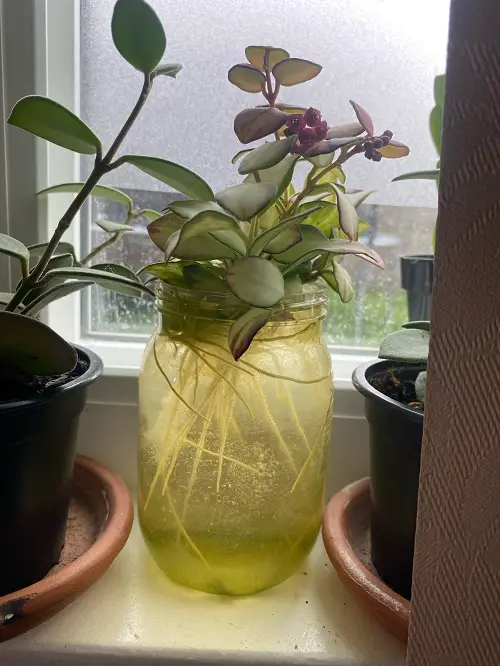
Botanical name: Hoya Carnosa
Hoya is an expensive vining, waxy succulent with shiny, furry blooms in white and pink. Perfect for hanging baskets, the cuttings of this stunning epiphytic houseplant also root well in water! Fill your container with clean water and drop in your clipping with nodes.
As always, avoid getting the leaves wet or submerged to prevent rot! Be patient with the rooting process, which may take over a month. Once rooted, move to hanging baskets and planters, and read this hoya care article for more tips!
6. Fuchsia

Botanical name: Fuchsia spp.
The decorative teardrop-shaped flowers of fuchsia come in exquisite shades of pink, red, and purple, livening up your home decor like no other! You need just a jar of clean water and indirect light to get your fuchsia cuttings to root, and that too within three weeks!
Before transplanting your fuchsia into a permanent container, top it with moist and well-draining soil. Once roots form, here are some incredible ways to grow fuchsia indoors!
7. Jasmine
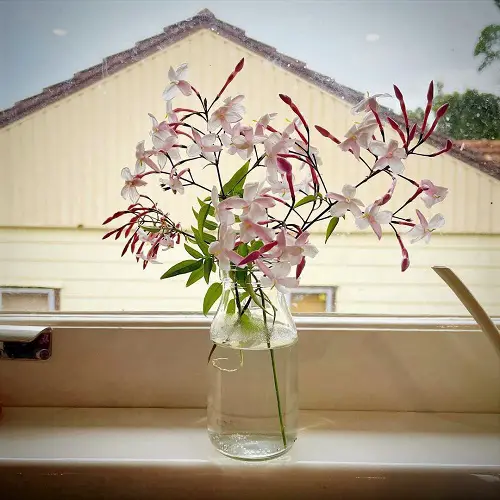
Botanical name: Jasmine spp.
Growing jasmine is easy even for a new gardener, especially from cuttings not only in soil but in water as well! Start by clipping a small section 4-5 inches long at an angle just below the leaf node. Place it in a glass of water, and keep it in a cool room.
Ensure your jasmine plant cutting gets ample sunshine. Once it matures, remember to prune the plant regularly to help it flourish and bloom!
8. Lavender
Botanical name: Lavandula spp.
Lavenders bloom from spring to summer, and you can propagate them in water by taking a 3-4 inch long fresh cutting and placing it in a crystal water vessel. As with all the cuttings mentioned above, remember to remove the leaves below and spare the ones on top!
And your lavender will start rooting quicker than when planted in soil, within two weeks for softwood cuttings. However, survival can be tricky when growing herb cuttings in water. Place it on a windowsill that receives dappled sunshine, and change the water regularly.
9. Hyacinth

Botanical name: Eichhornia crassipes
You can propagate hyacinth in water, but you have to make sure the bulb stays dry throughout—not even the bottom bit can touch the water! Hyacinth bulbs are typically propagated in hourglass-shaped glass jars—vases with narrow necks.
These allow you to place the bulb above the water without wetting the base. Keep it in darkness for several weeks until shoots and roots form. Then, gradually introduce dappled sunshine as the flowers bloom! Check out all these plants that grow in water, like hyacinth.
10. Petunia
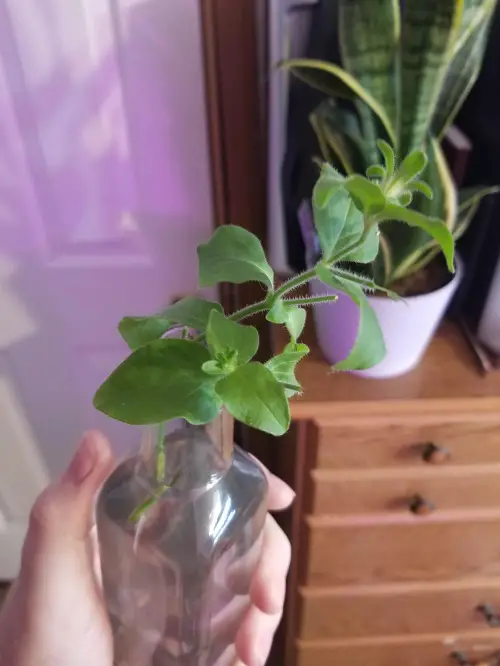
Botanical name: Petunia spp.
Petunia is a popular houseplant with trumpet-shaped flowers and beautiful furry foliage. In summer, propagate it by cutting a 4-6 inch long, flowerless stem. Drop it in a glass container with tepid water, and keep it under bright, indirect sunlight.
When cuttings sprout at the top and roots have formed sufficiently, you know your petunia propagation was successful. Then, it’s time to repot into larger containers or move to the garden.
11. Peace Lily
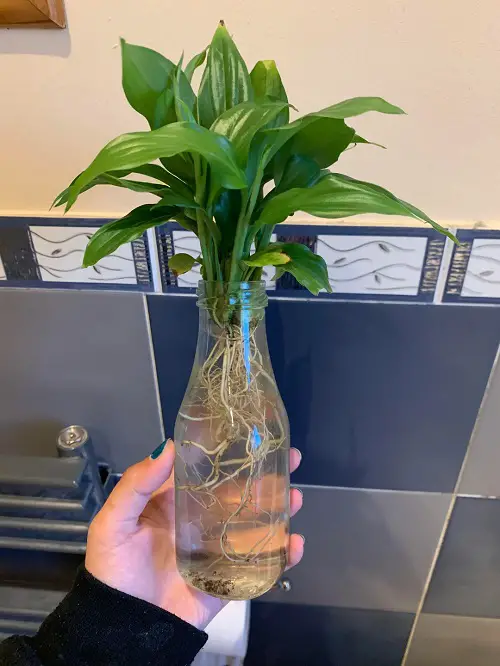
Botanical Name: Spathiphyllum spp.
Divisions of these eye-catching flowers root well in soil, but they look like a divine terrarium when done in water-filled glass jars! To grow your peace lily in water, ensure the plant crown sits above the waterline to prevent rot.
Since these aren’t cuttings but divisions, choose a healthy section with roots and ensure only they are fully immersed in tepid water. Pick a dreamy crystal jar as your plant’s home, and follow these peace lily fall tips to keep it thriving.
12. Paperwhite Narcissus
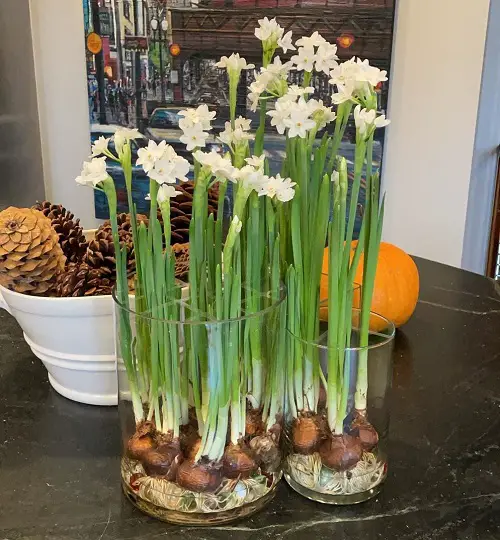
Botanical Name: Narcissus papyraceus
Narcissus papyraceus is native to the southern Mediterranean and has white single and double blooms. Like hyacinth, it grows from bulbs that absolutely cannot get wet! Use pebbles or stones to anchor the bulbs, or go with a glass vase with a thin neck.
Place the container in a well-lit area, and you will soon be the proud owner of an exquisite indoor floral display!
When propagating cuttings this way, change the water every 3-5 days and wipe down the container from within if it looks murky.


